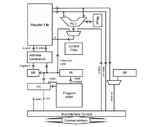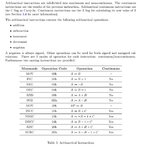tarjina
Junior Member level 3
Hi!
I need help in designing of a 16-bit processor's ALU.
It modifies the flags: zero, sign, overflow, carry
The arithmetic part has two kinds of operations: non-continuous(A+B) and continuous(A+B+C).
The ALU takes only 2 inputs. how am i going to provide three?
Let's take C as Carry; so, with continuous operation I might add a 64 bit number. a little help here would be much appreciated.
I have no idea how to do that.
Now coming to the addition part. It should update all the respected flags. Now, if the sum goes beyond the range, the overflow should be set. Then how am I going to correct my result? Or lets say I am adding (-FFFF-FFFF), So, the result will not fit in the dedicated area.
How am i going to show the result for this such cases.
Please let me know, if the questions are vague.
Thanks in advance.
I need help in designing of a 16-bit processor's ALU.
It modifies the flags: zero, sign, overflow, carry
The arithmetic part has two kinds of operations: non-continuous(A+B) and continuous(A+B+C).
The ALU takes only 2 inputs. how am i going to provide three?
Let's take C as Carry; so, with continuous operation I might add a 64 bit number. a little help here would be much appreciated.
I have no idea how to do that.
Now coming to the addition part. It should update all the respected flags. Now, if the sum goes beyond the range, the overflow should be set. Then how am I going to correct my result? Or lets say I am adding (-FFFF-FFFF), So, the result will not fit in the dedicated area.
How am i going to show the result for this such cases.
Please let me know, if the questions are vague.
Thanks in advance.

